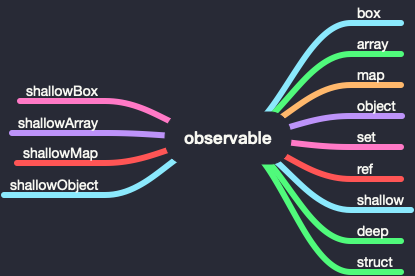Mobx 源码初探 - observable(二)
上一节讲到,
observable不仅支持decorator方式,还支持方法调用。
observable
age = observable(12)
observable 共有 13 种方法,其中 shallowBox、shallowArray、shallowMap 和 shallowObject 已经废弃。

box、shallowBox、array、shallowArray、map、shallowMap、set会判断参数是否大于 2,如果大于则报错。object会判断第二个参数是否为string,如果不是则报错。
ref、shallow、deep、struct
ref、shallow、deep、struct 四个方法很有意思,其中 deep 对应的是 deepDecorator 方法,当我们调用 @observable.deep 就相当于调用 @observable,剩下的三个则对应不同的 enhancer。
注:如果直接调用这个四个方法,会返回描述符,所以我们的调用方式仍然为
@observable.deep。
enhancer
mobx 共有四个 enhancer 函数。

deepEnhancer
deepEnhancer 在上一节已经讲过,其是任何 observable 都使用的默认的调节器。它将任何(尚未成为 observable )数组,映射或纯对象克隆并转换为 observable 对象,并将其赋值给给定属性。
shallowEnhancer
只能与集合组合使用。将任何分配的集合转换为 observable,但该集合的值将按原样处理。
referenceEnhancer
不转换为 observable。
function referenceEnhancer(newValue) {
// never turn into an observable
return newValue;
}
2
3
4
refStructEnhancer
就像 referenceEnhancer, 但会忽略结构上等于当前值的新值。
function refStructEnhancer(v, oldValue, name) {
if (true && isObservable(v))
throw "observable.struct should not be used with observable values";
if (deepEqual(v, oldValue)) return oldValue;
return v;
}
2
3
4
5
6
observable.box
用法
name = observable.box(2)
源码解读
observable.box 接收两个参数 value 和 options,方法内部首先判断是否以 decorator 方式调用,如果是则报错,否则调用 asCreateObservableOptions 生成 options。
if (arguments.length > 2) incorrectlyUsedAsDecorator("box");
var o = asCreateObservableOptions(options);
return new ObservableValue(value, getEnhancerFromOptions(o), o.name, true, o.equals);
2
3
asCreateObservableOptions 会校验传入的第二个参数格式,如果第二个参数为 null 或 undefined,则返回 defaultCreateObservableOptions。否则判断传入的类型是否为 string 和 object,如果都不是,则报错,否则进行进一步的校验。
function asCreateObservableOptions(thing) {
if (thing === null || thing === undefined) return defaultCreateObservableOptions;
if (typeof thing === 'string') return { name: thing, deep: true };
if (true) {
if (typeof thing !== 'object') return fail('expected options object');
Object.keys(thing).forEach(assertValidOption);
}
return thing;
}
2
3
4
5
6
7
8
9
在 observable.box 函数内部,同样也会调用 new ObservableValue 来生成 observable 数据,区别就是 enhancer 会根据传入的第二个参数判断使用使用哪种 enhancer,notifySpy 为 true 和最后一个参数。
// observable.box
new ObservableValue(value, getEnhancerFromOptions(o), o.name, true, o.equals);
// @observable
new ObservableValue(newValue, enhancer, adm.name + "." + propName, false);
2
3
4
ObservableValue
上一节我们提到了关于 ObservableValue 的一部分知识,这里会继续深入了解。ObservableValue 接收 value, enhancer, name, notifySpy, equals 几个参数。
由于传入的 notifySpy 为 true,所以相比 @observable 多走一个判断。它会首先判断当前全局是否有全局 spy 监听器,如果有,则发送一个事件,剩下的和 @observable 所做的事相同。
if (notifySpy && isSpyEnabled()) {
// only notify spy if this is a stand-alone observable
spyReport({ type: "create", name: _this.name, newValue: "" + _this.value });
}
2
3
4
observable.array
方法内部实例化 ObservableArray,ObservableArray 继承 StubArray,StubArray 继承 Array。
var extendStatics = function(d, b) {
extendStatics =
// IE <=10 无 Object.setPrototypeOf
Object.setPrototypeOf ||
// 用来判断是否支持 __proto__,__proto__ 不支持 IE <= 10,处于此类环境 ({ __proto__: [] }) instanceof Array 会返回 false
({ __proto__: [] } instanceof Array &&
function(d, b) {
d.__proto__ = b;
}) ||
function(d, b) {
for (var p in b) if (b.hasOwnProperty(p)) d[p] = b[p];
};
return extendStatics(d, b);
};
function __extends(d, b) {
extendStatics(d, b);
function __() {
this.constructor = d;
}
d.prototype = b === null ? Object.create(b) : ((__.prototype = b.prototype), new __());
}
var ObservableArray = (function(_super) {
...
__extends(ObservableArray, _super);
...
})(StubArray);
2
3
4
5
6
7
8
9
10
11
12
13
14
15
16
17
18
19
20
21
22
23
24
25
26
27
28
__proto__
我们从继承源码中看见这样一句代码,({ __proto__: [] } instanceof Array) ,这句代码啥意思呀?这是个什么造型啊,挺别致啊。我们在控制台打印下,发现输出 true,于是开始怀疑人生中。。。

MDN:__proto__的读取器(getter)暴露了一个对象的内部 [[Prototype]] 。对于使用对象字面量创建的对象,这个值是 Object.prototype。对于使用数组字面量创建的对象,这个值是 Array.prototype。对于functions,这个值是Function.prototype。
({ __proto__: [] } instanceof Array) // true
({ __proto__: {} } instanceof Object) // true
({ __proto__: function(){} } instanceof Function) // true
({ __proto__: 2 } instanceof Object) // true
({ __proto__: 'abc' } instanceof Object) // true
({ __proto__: true } instanceof Object) // true
({ __proto__: NaN } instanceof Object) // true
({ __proto__: null } instanceof Object) // false
Object.getPrototypeOf({ __proto__: null }) // null
2
3
4
5
6
7
8
9
在控制台可以看到 { __proto__: null },生成的对象没有原型链,这与我们通过 Object.create(null) 得到的结果是一致的。
我们开始怀疑是不是通过 {__proto__: []} 与 Object.create([]) 得到的结果一致?由于 Object.create 第一个参数接收对象,故只测试以下情况。
Object.create([]) instanceof Array // true
Object.create({}) instanceof Object // true
Object.create(function(){}) instanceof Function // true
Object.getPrototypeOf(Object.create(null) ) // null
2
3
4
observable.map
return new ObservableMap(initialValues, getEnhancerFromOptions(o), o.name);
observable.set
return new ObservableSet(initialValues, getEnhancerFromOptions(o), o.name);
observable.object
return extendObservable({}, props, decorators, o);